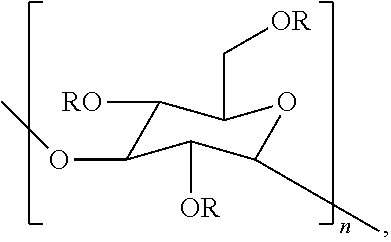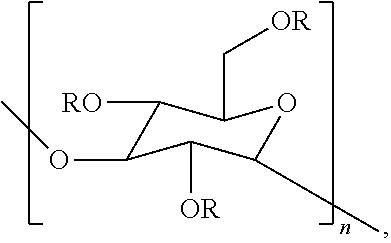Compositions containing one or more poly alpha-1,3-glucan ether compounds
a technology of glucan ether and polyalpha-1, which is applied in the field of compositions containing one or more polyalpha-1,3glucan ether compounds, can solve the problems of limiting the use of these components together in a formulation, the lack of stability of cellulose-based polymers to cellulases, and the inability to stabilize these polymers. to achieve the effect of increasing the viscosity of the aqueous composition
- Summary
- Abstract
- Description
- Claims
- Application Information
AI Technical Summary
Benefits of technology
Problems solved by technology
Method used
Image
Examples
examples
[0280]The present disclosure is further exemplified in the following Examples. It should be understood that these Examples, while indicating certain preferred aspects herein, are given by way of illustration only. From the above discussion and these Examples, one skilled in the art can ascertain the essential characteristics of the disclosed embodiments, and without departing from the spirit and scope thereof, can make various changes and modifications to adapt the disclosed embodiments to various uses and conditions.
Abbreviations
[0281]The meaning of some of the abbreviations used herein is as follows: “g” means gram(s), “h” means hour(s), “mL” means milliliter(s), “psi” means pound(s) per square inch, “wt %” means weight percentage, “μm” means micrometer(s), “° C.” means degrees Celsius, “mg” means milligram(s), “mm” means millimeter(s), “m” means meter(s), “μL” means microliter(s), “mmol” means millimole(s), “min” means minute(s), “mol %” means mole percent, “M” means molar, “rpm”...
examples 1-2
Effect of Cellulase on Carboxymethyl Poly Alpha-1,3-Glucan (CMG)
[0328]These examples disclose the superior stability of a poly alpha-1,3-glucan ether, CMG, in the presence of cellulase compared to carboxymethyl cellulose (CMC).
[0329]Solutions (1 wt %) of CMC (Mw=90000, DoS=0.7) or CMG (Mw=101500, DoS=0.47, sample designation D102709-44 in Table 1) were treated with cellulase or amylase (Table 3) following the above-described procedure. CMC Mw decreased by over 60% when treated with cellulase for 24 hours (Table 3, Example 1.1). Conversely, CMG polymer Mw was reduced by only 1.1% and 10.6% when treated with cellulase (Table 3, Examples 2.1 and 2.4, respectively). Both CMC and CMG were stable against degradation by amylase (Table 3, Examples 1.2, 2.2 and 2.3). Control polymer solutions underwent the same treatment protocol, with the exception that neither a cellulase or amylase were included in the treatment. The controls indicate that the 24-hour agitation aspect of the above treatme...
example 3
Creating Calibration Curves for Direct Red 80 and Toluidine Blue 0 Dyes Using UV Absorption
[0332]This example discloses creating calibration curves useful for determining the relative level of adsorption of poly alpha-1,3-glucan ether derivatives onto fabric surfaces.
[0333]Solutions of known concentration (ppm) were made using Direct Red 80 and Toluidine Blue O dyes. The absorbance of these solutions was measured using a LAMOTTE SMART2 Colorimeter at either 520 or 620 nm. The absorption information was plotted in order that it could be used to determine dye concentration of solutions which were exposed to fabric samples. The concentration and absorbance of each calibration curve are provided in Tables 4 and 5.
TABLE 4Direct Red 80 Dye Calibration Curve DataDyeAverageConcentration Absorbance(ppm)@520 nm250.82333333322.50.796666667200.666666667150.51100.3750.2
TABLE 5Toluidine Blue O Dye Calibration Curve DataDyeAverageConcentrationAbsorbance(ppm)@620 nm12.51.41101.22666666770.8850.6766...
PUM
| Property | Measurement | Unit |
|---|---|---|
| Viscosity | aaaaa | aaaaa |
Abstract
Description
Claims
Application Information
 Login to View More
Login to View More - R&D
- Intellectual Property
- Life Sciences
- Materials
- Tech Scout
- Unparalleled Data Quality
- Higher Quality Content
- 60% Fewer Hallucinations
Browse by: Latest US Patents, China's latest patents, Technical Efficacy Thesaurus, Application Domain, Technology Topic, Popular Technical Reports.
© 2025 PatSnap. All rights reserved.Legal|Privacy policy|Modern Slavery Act Transparency Statement|Sitemap|About US| Contact US: help@patsnap.com



